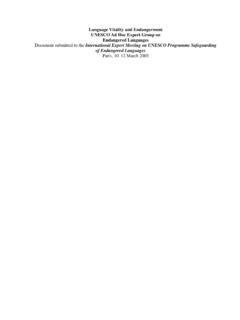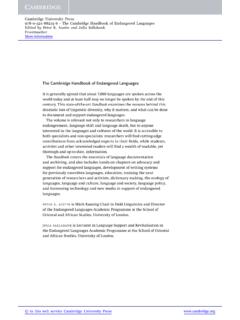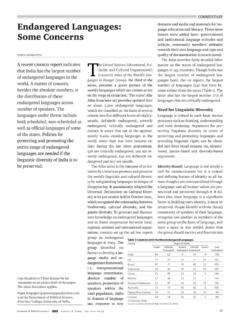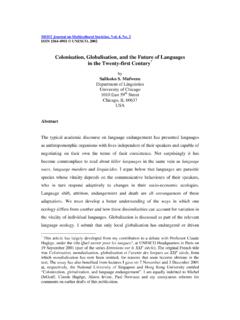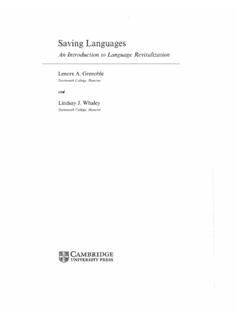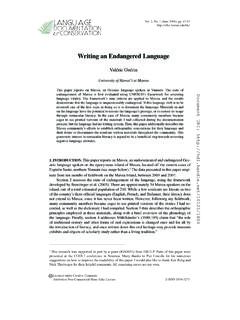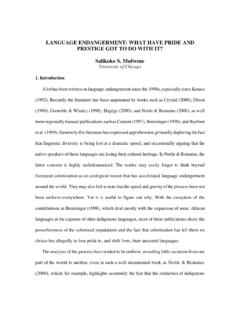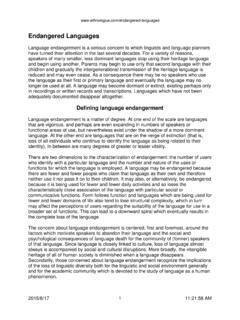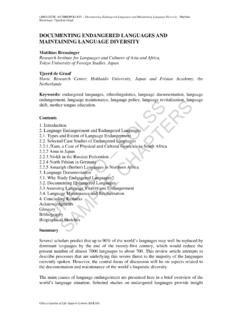Transcription of Vitality and Endangerment of Contemporary Kurukh
1 AesthetixMS 2016. This Open Access article is published under a Creative Commons Attribution Non-Commercial International License ( ), which permits non-commercial re-use, distribution, and reproduction in any medium, provided the original work is properly cited. For citation use the DOI. For commercial re-use, please contact Vitality and Endangerment of Contemporary Kurukh Alisha Vandana Lakra1 & Md. Mojibur Rahman2 1 Senior Research Fellow, Department of Humanities and Social Sciences, Indian Institute of Technology (Indian School of Mines), Dhanbad-826004 (Jharkhand) India. ORCID ID 0000-0002-6707-6849 Email: 2 Associate Professor, Department of Humanities and Social Sciences, Indian Institute of Technology (Indian School of Mines), Dhanbad-826004 (Jharkhand) India.
2 ORCID ID 0000-0002-8454-0981 Received May 31, 2017; Revised July 24, 2017; Accepted July 27, 2017; Published August 18, 2017. Abstract A multilingual society shares some common social and cultural situations affecting the linguistic features of a language . It eventually appears in linguistic performances of the speech community which might lead to its Endangerment . The Kurukh language , spoken in and around the district of Ranchi in Jharkhand, India, appears in a multilingual society where it is constantly affected by its neighbouring and dominant languages. The restricted use of the language has led to its Endangerment . This paper describes the degree of Endangerment of the Kurukh language and also assesses its Vitality with reference to the factors proposed by UNESCO.
3 The study investigates the speech performances of the speakers of Kurukh to assess the extent of code-mixing. Keywords: Endangerment , Kurukh , code-mixing. Introduction In India, there are six distinct language families which are spoken by millions. They are Indo Aryan, Dravidian, Iranian, Nuristani, Austro Asiatic and Tibeto - Burman language families. There are approximately more than 1600 languages spoken in India at present, out of which the government has recognized only 122 as the scheduled/official languages.(Abbi, 2012). Out of the 122 scheduled languages, 14 are Indo- Aryan, 4 are Dravidian, and the rest are Tibeto- Burman, and Austro Asiatic languages. Among the present 122 scheduled languages of India, 88 are tribal languages and still, there are many tribal languages which are not recognized by the government of India.
4 (Benedikter, 2009). Bhadriraju Krishnamurti, in 1961, geographically classified the Dravidian languages into Central, South and North Dravidian. He was the first to suggest the name North Dravidian for an ethnic group of Kurukh , Malto, and Brahui. In 1970, Andronov further sub- categorized the North Dravidian languages in which he kept Kurukh and Malto under north- eastern and Brahui under north-western. Kurukh is a North Dravidian language of the Oraon tribe which is spoken by approximately two millions people of the Chotanagpur plateau of the East-Central India. It is Rupkatha Journal on Interdisciplinary Studies in Humanities (ISSN 0975-2935), Vol. IX, No. 2, 2017 DOI: Full Text: 351 Rupkatha Journal on Interdisciplinary Studies in Humanities, V9N2, 2017 spoken in Jharkhand, Bihar, Assam, West Bengal, Orissa, Tripura (Ethnologue: Languages of the World, 2001 Census).
5 The tribe was not native to the land before they entered Chotanagpur plateau. There have been speculations about their origin and their migration paths. Historiographical mapping of Kurukh Origin The scholars have three different opinions about the origin of Kurukh which is spoken in Jharkhand (specifically Ranchi and its neighbouring villages). (Tirkey, 20-22) South and South- East India According to S. C. Roy, Kurukh speakers might have come from Coorg, a small place in South India. Some of the scholars hold the views of their entrance from the South East Asia. Gujarat Elefenbein, in 1987, proposed Bloch s hypothesis, according to which the Brahui tribe migrated from Baluchistan (area of the Indus Valley) in different directions.
6 The three tribes moved towards the south- east from Baluchistan of Pakistan. The fourth tribe went to Sindh which is the province of Pakistan where the tribe still speaks Brahui. One of the tribes which went to the south- east, further split into two groups at Rohtasgarh in Bihar. After the splitting, one group went to the Rajmahal Hills in Santhal Pargana and the other went to the Chotanagpur plateau where Kurukh is spoken ( Kurukh World). Joseph Elegenbein is of the opinion that the Kurukh / Kurux (Oraons) and the Malto tribes earlier came from the north- west direction and settled around the river Narmada near Baruch in Gujarat and later moved via Ujjain to Rohtasgarh, while the Brahui went to Baluchistan in the Western direction.
7 (Tirkey, 2013) Harappa The Indus Valley Civilization is also known as Harappan civilization. Before 2500 , the Oraons lived near the Indus Valley and they lived a sophisticated life there. The valley was consistently destroyed by flood and diseases and the climate became dry. It is also believed that the Oraons were attacked by the Aryans and were forced to leave the place. They have migrated in 2500 to the north- east and the south- west region from Baluchistan. (Tirkey, 21-22) Migration Paths In 1927, according to Grinard, Oraon and Maler occupied the land between the rivers Ghagra, Tons in the south-west and Sone River in Bihar. The Oraons were removed from the erstwhile Shahabad district of Bihar and then they fled to the north at Haridwar in Uttar Pradesh.
8 After that, they joined the Aryan army of the Kauravas against the Pandavas. They were defeated by the Pandavas and moved towards the South India. They passed through the forest of Brindavan on the bank of river Yamuna and settled in the place called Pipripat in Gujarat. They again moved to the Rohtasgarh and built a fort there and lived there for many years. After that, they were defeated in a battle against the Mughals and were forced to leave the Fort (Mishra, ). The Oraons then took shelter in the Chotanagpur plateau and since then they have been living with the other ethnic tribal groups of the plateau. 352 Vitality and Endangerment of Contemporary Kurukh Settlement in the Chotanagpur Plateau The central and western parts of the Ranchi district are generally described as the Chotanagpur.
9 The plateau consists of the two levels of the elevation of 2000 feet and 1000 feet above sea level. The upper plateau covers about the two- third of the district area and comprises of its northern, central, and western parts (Roy, 38-39). The betrayal at the hands of the milkmaid led to the reoccurrence of the attack to which it caused the dislodgement of the tribe from Rohtasgarh. After the defeat, the tribe entered the Plateau and took shelter (Tirkey). Demographic distribution, population, and works on Kurukh language The tribe is residing in Ranchi district of Jharkhand, Madhya Pradesh, Orissa, Bihar, Chattisgarh, Assam, Tripura, and Andaman. The present population of the tribe is approximately two million (Census 2001, Ethnologue: Languages of the World).
10 Works on the Kurukh language : i. Brief Grammar and Vocabulary of the Oraon language by Rev. F. Batsch, 1866 ii. Kurukh (Oraon)- English Dictionary by Ferdinand Hahn, 1903 iii. Kurukh Grammar by Ferdinand Hahn, 1911 iv. A Grammar of the Oraon language by A. Grinard, 1924 v. An Oraon English Dictionary by A. Grinard, 1924 vi. Introduction of Kurukh Script Tolong Siki by Narayan Oraon vii. Establishment of Kurukh Literary Society Distinctive features of the Kurukh language in brief: i. Kurukh , like other Dravidian languages, is an agglutinative language ii. The sentence structure is subject+object+verb (SOV) iii. In its morphological construction, there is suffixation, there is no infix or prefix to the language iv. Vowel nasalization is a contrastive and distinctive feature v.


